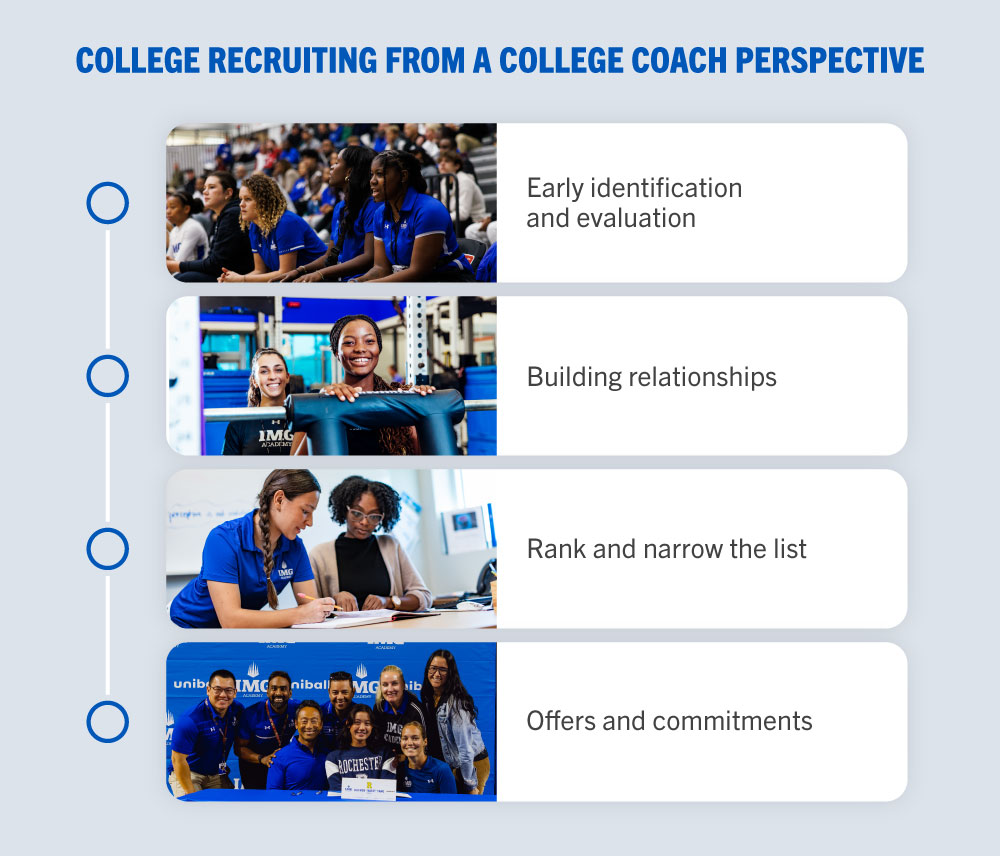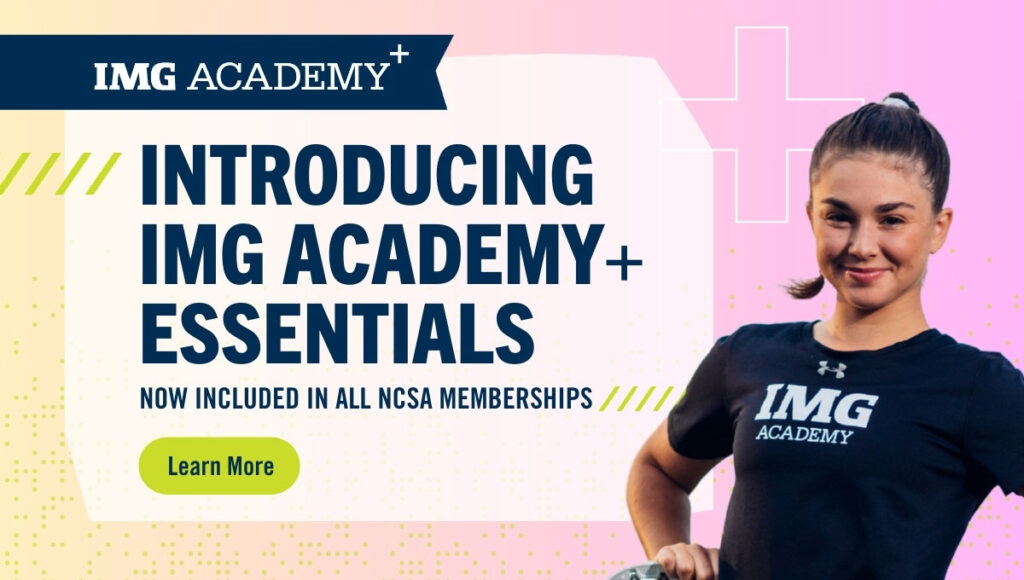If you’re dreaming of playing college basketball, you’re not alone! But how do you get noticed by college coaches? It starts with doing your research and marketing yourself. Build an online profile, create a highlight video showcasing your skills and leadership, and actively reach out to coaches. This guide will answer the most common questions about how to get recruited for college basketball.
Quick Links
What are the chances of playing women’s basketball in college?
Only about 4.5% of high school basketball players move on to play at the NCAA level and less than 1% move on to the NAIA. But with the right preparation, dedication, and exposure, you can be one of them.
The recruiting process for women’s basketball
When it comes to recruiting, college coaches typically follow a process to find the right athletes for their program. They’re looking for players who excel on the court, fit their team culture, and demonstrate a strong work ethic. Understanding how coaches evaluate talent and make decisions can help you better position yourself to stand out. Here’s a closer look at the recruiting process through the eyes of a college coach:
- Early identification and evaluation: Coaches start identifying potential recruits as early as freshman and sophomore years. Coaches attend games, tournaments, and showcases to see athletes compete in person. They also review highlight videos and stats to assess an athlete’s athleticism, basketball IQ, and overall fit for their team.
- Building relationships: Building relationships with recruits, their high school or club coach, and their family is essential for gauging the recruit’s commitment, attitude, and work ethic. Early in the process, coaches send out questionnaires, followed by more in-depth communications when the official NCAA contact period begins.
- Rank and narrow the list: As the recruiting process moves forward, coaches rank recruits based on their performance and fit for the program. This is when they narrow down the list of athletes they’re seriously considering and begin inviting top women’s basketball recruits for campus visits.
- Offers and commitments: After the evaluation and ranking process, coaches will begin making verbal offers to athletes they find to be a good fit for their team. Offers are often extended after in-person evaluations, and athletes are encouraged to visit the campus and meet with the coaching staff.

While college coaches have a structured process for recruiting, much of the recruiting process depends on the athletes themselves. Coaches are evaluating talent, but it’s up to recruits to stay proactive—building their profiles, reaching out to programs, and showcasing their skills at events. The more effort you put in, the better your chances of standing out.
How to get recruited to play women’s college basketball
Recruiting isn’t a linear, clear-cut process. You could be nearing the end of your recruiting journey with one coach while simultaneously just beginning it with another. But knowing what steps you can take to create a communication strategy and market yourself will help you secure a scholarship offer.
- Create your recruiting profile. Showcase your skills with an NCSA recruiting profile to get seen by over 40,000 college coaches. Include key stats, game footage that highlights your strengths and your academic achievements.
- Research and build your target list. Research the different division levels and visit a team’s roster to find their true athletic and academic fit.
- Play at the highest level possible: To accurately assess a recruit’s ability to compete in college, coaches want to see them play against top-tier athletes. Typically, AAU basketball and varsity teams accomplish this.
- Compete in the summer during live periods: These stretches in the offseason allow college basketball scouts and coaches to hit the road and scout several players at once. Remember to reach out to coaches before you attend a tournament or camp.
- Excel academically. The NCAA Eligibility Center determines the academic eligibility and amateur status for all NCAA Division 1 and Division 2 athletes. Understand the requirements to stay on track.
- Create a highlight film. The best way to secure an in-depth and in-person evaluation is by sending coaches a highlight video and a full game film. It’s a quick way to show them a snapshot of your skill set.
- Be proactive. Start by sending an introductory email that includes your online profile, highlight video, academic information, outstanding athletic achievements and personal interest in the program. Then follow up with a phone call.
How do college scouts evaluate women’s basketball recruits?
College coaches consider several factors when determining an athlete’s ability:
- Physical characteristics. Height and body frame, athleticism and strength are important characteristics coaches look at.
- Technical skills. Coaches want to recruit student-athletes who have mastered the fundamentals.
- Basketball IQ. Scouts determine the athlete’s game awareness and their ability to make the right decisions in the moment.
- Academics. Student-athletes with a solid GPA and test scores are more likely going to be admitted into the university and have an easier college transition. Plus, strong academics also tell coaches that the recruit is responsible and disciplined—traits they highly value.
- Character and work ethic: Leadership, attitude, coachability, and resilience often set top recruits apart. Coaches want players who bring positive energy to the team and show consistent effort.
Of course, what coaches look for in a recruit also depends on their program’s specific needs. The best way to determine that is to establish a relationship with the coach and speak to them directly. Another quick way is to visit the team’s website and analyze their roster.
Does height matter in women’s basketball recruiting?
While physical characteristics, like height, matter to college coaches, they aren’t the only consideration. The average height of women’s college basketball players varies slightly from division to division.
See the full list of recruiting guidelines for women’s basketball players.
Keep in mind that this should be used as a helpful guideline and not something set in stone. Players who don’t fall within these ranges are recruited every year by college coaches.
The best way to understand a coach’s recruiting needs is to establish a relationship with them early on and analyze their current team roster.
What is basketball IQ?
Basketball IQ refers to a player’s ability to make smart, efficient decisions on the court. It encompasses their understanding of the game, ability to read plays, and awareness of both their teammates and opponents.
Should I attend basketball camps to get noticed by college coaches?
Yes. Basketball camps provide an opportunity to refine your skills while showcasing your talent in front of college coaches. For more details on how to choose the right camp, check out our full guide.
Do I need a basketball highlight video?
Yes, a strong basketball highlight video is key to catching a coach’s eye and earning a possible in-person evaluation. Check out our full guide for expert tips on creating the perfect highlight reel.
How do I contact college basketball coaches?
Check out our guide for a detailed breakdown of how to contact basketball coaches via phone, email, and social media.
Should I play club basketball? Will it help me get recruited?
AAU, which stands for the Amateur Athletic Union, can be a valuable tool in gaining exposure to college coaches. It provides a platform for recruits to compete against top tier athletes in tournaments across the country. For NCAA Division 1 prospects specifically, AAU has become somewhat of a standard for getting noticed by college coaches. AAU shouldn’t be viewed as a requirement to obtain a college basketball scholarship outside of NCAA Division 1. Several prospects have skipped the AUU circuit and moved on to successful college and professional careers.
JOIN ncsa TODAY!
At NCSA, we have a team of former student-athletes who’ve been through this process themselves. We understand the nerves that come with that initial outreach, and we’re here to help you get ready. Take the next step. Create a free profile today!

